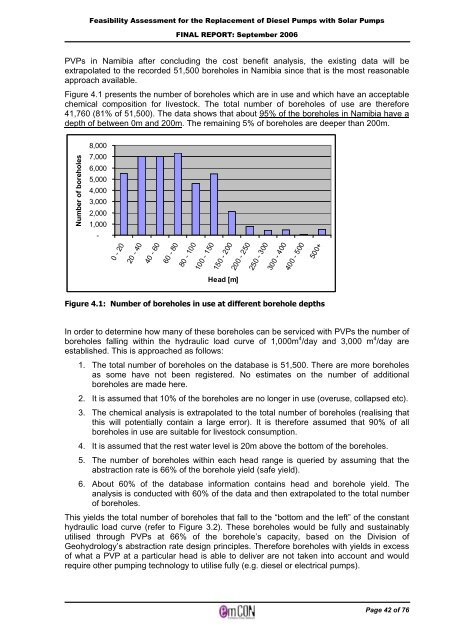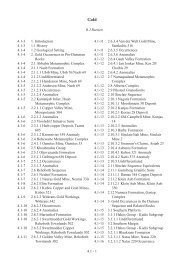Solar PV water pumping study - FINAL REPORT ... - UNDP, Namibia
Solar PV water pumping study - FINAL REPORT ... - UNDP, Namibia
Solar PV water pumping study - FINAL REPORT ... - UNDP, Namibia
Create successful ePaper yourself
Turn your PDF publications into a flip-book with our unique Google optimized e-Paper software.
Feasibility Assessment for the Replacement of Diesel Pumps with <strong>Solar</strong> Pumps<br />
<strong>FINAL</strong> <strong>REPORT</strong>: September 2006<br />
<strong>PV</strong>Ps in <strong>Namibia</strong> after concluding the cost benefit analysis, the existing data will be<br />
extrapolated to the recorded 51,500 boreholes in <strong>Namibia</strong> since that is the most reasonable<br />
approach available.<br />
Figure 4.1 presents the number of boreholes which are in use and which have an acceptable<br />
chemical composition for livestock. The total number of boreholes of use are therefore<br />
41,760 (81% of 51,500). The data shows that about 95% of the boreholes in <strong>Namibia</strong> have a<br />
depth of between 0m and 200m. The remaining 5% of boreholes are deeper than 200m.<br />
Number of boreholes<br />
8,000<br />
7,000<br />
6,000<br />
5,000<br />
4,000<br />
3,000<br />
2,000<br />
1,000<br />
-<br />
0 - 20<br />
20 - 40<br />
40 - 60<br />
60 - 80<br />
80 - 100<br />
100 - 150<br />
150 - 200<br />
Head [m]<br />
200 - 250<br />
250 - 300<br />
300 - 400<br />
400 - 500<br />
Figure 4.1: Number of boreholes in use at different borehole depths<br />
In order to determine how many of these boreholes can be serviced with <strong>PV</strong>Ps the number of<br />
boreholes falling within the hydraulic load curve of 1,000m 4 /day and 3,000 m 4 /day are<br />
established. This is approached as follows:<br />
1. The total number of boreholes on the database is 51,500. There are more boreholes<br />
as some have not been registered. No estimates on the number of additional<br />
boreholes are made here.<br />
2. It is assumed that 10% of the boreholes are no longer in use (overuse, collapsed etc).<br />
3. The chemical analysis is extrapolated to the total number of boreholes (realising that<br />
this will potentially contain a large error). It is therefore assumed that 90% of all<br />
boreholes in use are suitable for livestock consumption.<br />
4. It is assumed that the rest <strong>water</strong> level is 20m above the bottom of the boreholes.<br />
5. The number of boreholes within each head range is queried by assuming that the<br />
abstraction rate is 66% of the borehole yield (safe yield).<br />
6. About 60% of the database information contains head and borehole yield. The<br />
analysis is conducted with 60% of the data and then extrapolated to the total number<br />
of boreholes.<br />
This yields the total number of boreholes that fall to the “bottom and the left” of the constant<br />
hydraulic load curve (refer to Figure 3.2). These boreholes would be fully and sustainably<br />
utilised through <strong>PV</strong>Ps at 66% of the borehole’s capacity, based on the Division of<br />
Geohydrology’s abstraction rate design principles. Therefore boreholes with yields in excess<br />
of what a <strong>PV</strong>P at a particular head is able to deliver are not taken into account and would<br />
require other <strong>pumping</strong> technology to utilise fully (e.g. diesel or electrical pumps).<br />
500+<br />
Page 42 of 76




